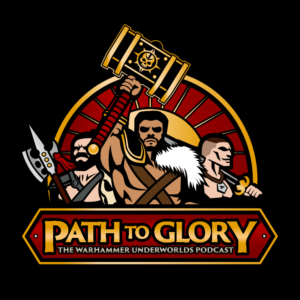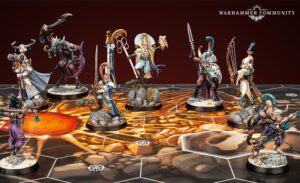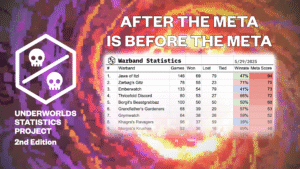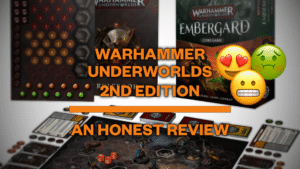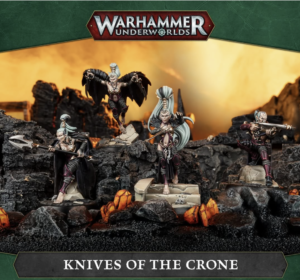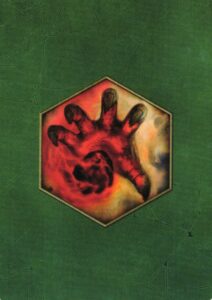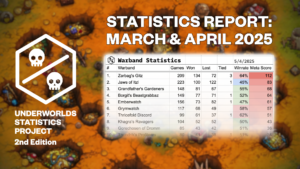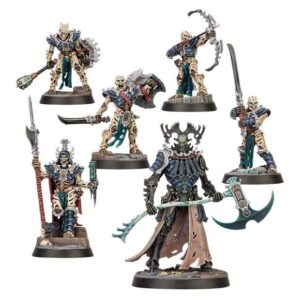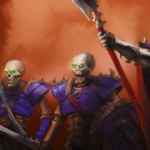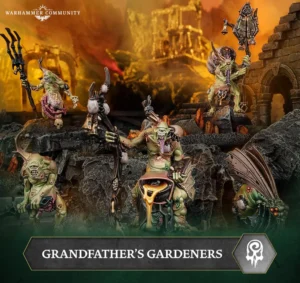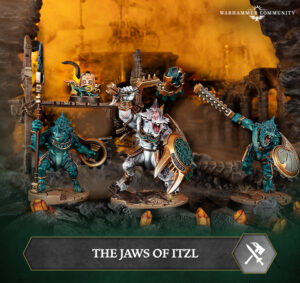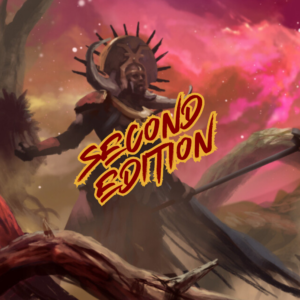
Hello Gloryseekers,
Jonathan here. Games Workshop recently announced that Harrowdeep, the 5th season of Warhammer Underworlds, will include a new way to play the game aimed at new players: Rivals Format.
In this article I will be covering how the format works, what my thoughts on and hopes are for the format, and go over each of the deck options we have access to right now.
____________________
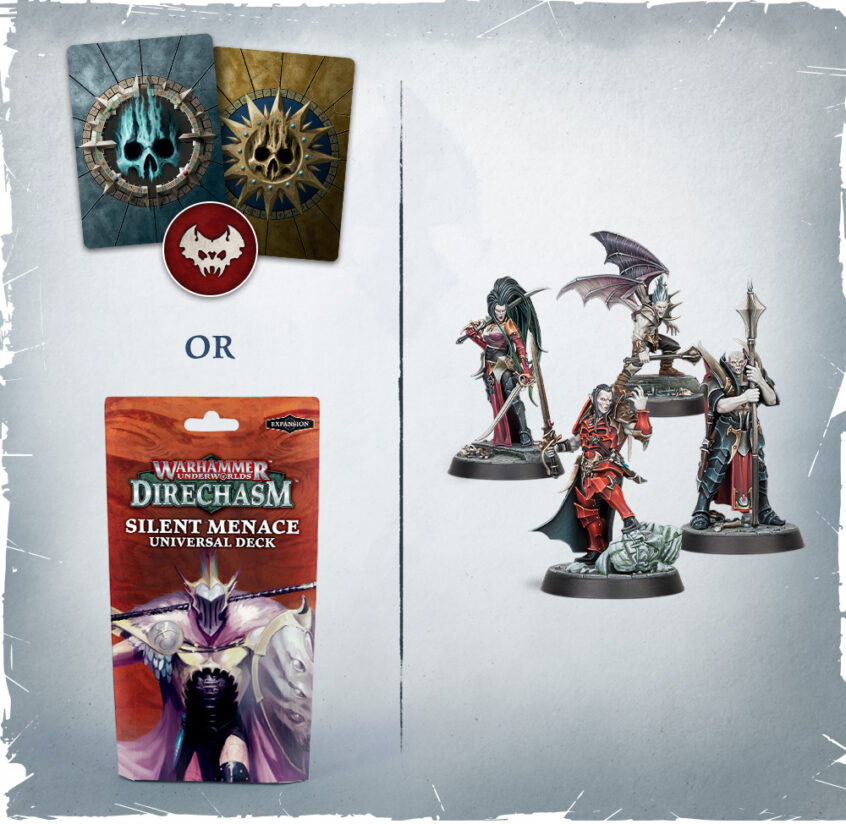
How It Works:
As far as we know, the rules of the format are fairly simple: Unlike the other formats of the game, there is no deck building in the Rivals Format. Instead, you choose a warband and one of the pre-built decks available to them, and play against other players that did the same.
For all 36 current Warbands and all future warbands, there will be universal decks to choose from. At the time of writing this there is only one of these pre-made decks, the Silent Menace Universal deck, with more releasing in the future.
For the newest 20 warbands from the Beastgrave Season (as well as Lady Harrow’s Mournflight and Ironsoul’s Condemners) and later, you also have the option of taking all of the Warband’s faction cards and using them as a complete deck.
Other than that, it’s basically just the Underworlds we know and love, with generally fewer rules to pay attention to (since only one warband each will have things like Hunger and Primacy, and there should be less Hunter and Quarry around), and a better idea what sort of decks people have (usually their faction deck, at first anyway).
____________________
What I Think About It
In my opinion, there are a lot of things to love about Warhammer Underworlds, and high level competitive events, and deck building is certainly two of them, but so are things like:
- Meeting and getting to know other people that play the game.
- Playing the game itself.
- Teaching people to play the game.
- Trying to figure out how to make a specific deck or strategy work with a specific warband (having enjoyed playing weird off-meta things like Hold Objective Magore’s, Full Aggro Hrothgorn, and so on).
- Competing in local events.
And I think Rivals might be decent enough for those things. At its core, the Rivals Format is a beginner format, which basically takes all of the good and bad aspects of deck building (it’s a lot of fun, but also requires a lot of time, money, and skill to do well), and puts those aside in order to make the game very accessible right away, which I think has some benefits.
In my view, although the puzzle and counter play of deck building is definitely one of the strengths of Warhammer Underworlds, it also has the necessary and even purposeful result of making some combinations of cards much better than others, and giving an advantage to players with both the cards and skills to build more powerful decks. In many ways this is how things should be in a card game like this, but it does make it harder (from money, time, and game learning curve perspectives) for new players to jump into the game at anything close to the same level as players with larger collections and have anything resembling a competitive experience.
In its current form, I don’t think the new Rivals Format should or could fully replace the Championship format in game nights, tournaments, or Grand Clashes, but I don’t think that’s the point.
By simply existing, the Rivals Format helps mitigate the number of times a newer player gets auto-stomped by a veteran player with an infinitely better deck because it is simple for veteran players to always have a Rivals deck on hand, and for new players to let their opponents know that is the format have the cards to play. This format should then lead to a more competitive experience for both players, since the game is objectively more balanced than it would be with a new player deck vs a Championship deck, and both players should have similarly weak decks compared to Championship.
I would also say that this experience is also very likely more enjoyable for both players, as the new player doesn’t really know what they are missing card wise, and shouldn’t be completely stomped, and the veteran player gets to use some cards they probably wouldn’t otherwise, and could actually be in danger of losing some games if the dice don’t go their way.
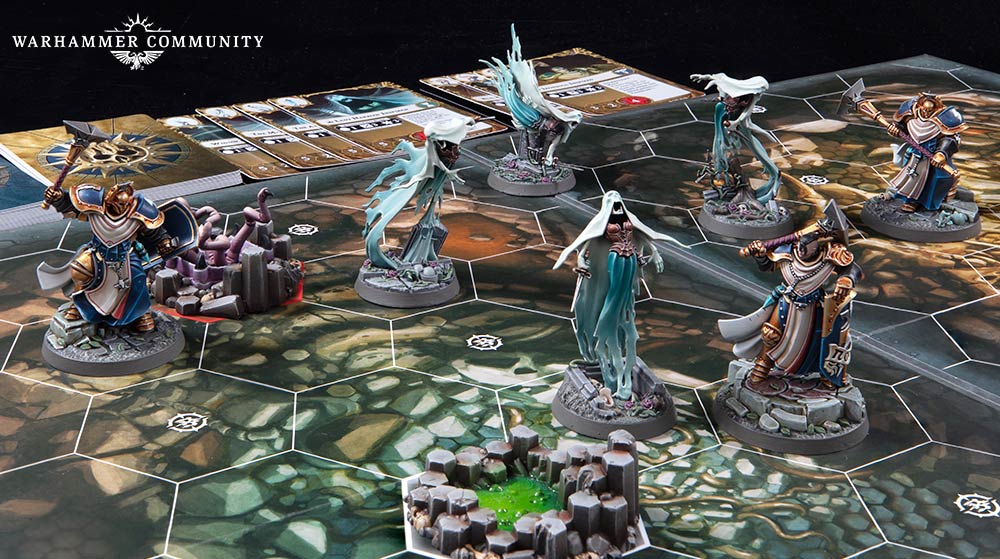
All of that said, I think the biggest issue with this format will always be the quality of the decks available. As we will get into below, calling the Silent Menace expansion a “deck” is a bit of a stretch from most player’s perspectives, and some of the current legal faction decks are not much better (poor Wurmspat).
Although these decks by definition don’t have to be strong enough to meaningfully compare to Championship decks, I do think they need to feel cohesive enough to be enjoyable for new players to pick-up and play. Because Rivals is likely the first look new players will have at the game, and if it’s not fun, they may never even make it to the more complex and enjoyable Championship format.
So, I do think that the long term viability and popularity of this format will depend a lot on what the decks actually like. If they are as randomly thrown together as the current examples, I think I will be less excited by this format. On the flip side, if the decks are actually something like a functioning deck, with a general theme to the objective cards (such as aggro, hold objective, control, etc) and fairly decent power cards that solve various problems (accuracy, speed, durability, etc), in a way where there are a few decks to choose from per warband, and each deck is different, flavorful, and actually sort of balanced against the other Rivals decks, I could actually see this format being pretty fun. This seems like no small design feat, though.
At the very least, even if the decks are largely bad and boring, I still think Rivals is a good ceiling on the power of veteran decks while they show new players the ropes, even if it’s only for a few games before graduating to the Vanguard or Championship formats.
All of that said, let’s jump into the current decks!
____________________
The Decks:
There are currently 20 legal warbands for the Rivals format, with presumably 8-10 more coming in the next season.
The goal of this section of the article is to talk about these warbands and their faction decks in order to bring new players up to speed on their options/what to expect across the table, and to establish some kind of general Rivals Format tier list. As new warbands come out, we will be sure to talk about each new Warbands Rivals deck in our warband reviews, as well as the normal card ratings from a championship perspective.
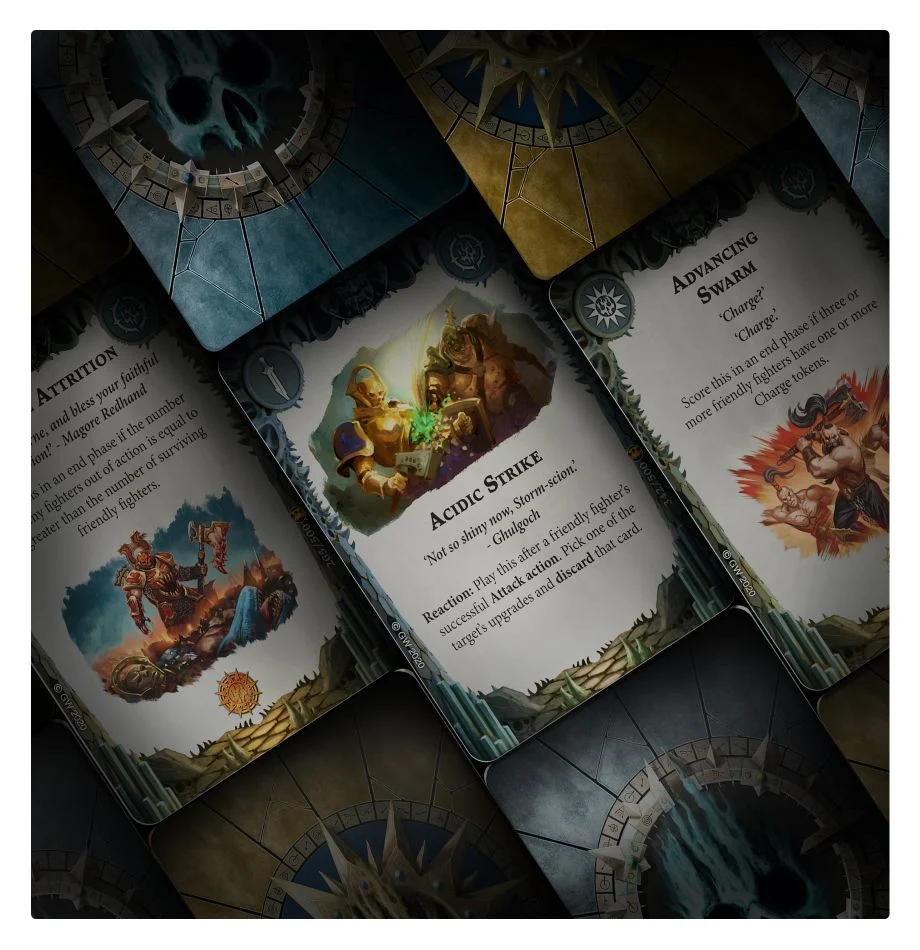
When talking about the decks, I will likely focus the most on the objective cards, because the ease in which a warband is able to complete objectives and accrue glory is usually the biggest factor to winning games. If a warband has bad objectives, then it’s much harder to win games than if they just had weak gambits or upgrades. Also, because you do not get to choose what objectives are in the decks, they will really force you to play a certain way, which may or may not work well depending on the playstyle/warband combination. The number of surges and total glory will also have a large effect on the power of these decks, with more generally being a good thing.
I will give each a rating from A to D, with A and B being options I would probably recommend giving a try, and C and D being options I would probably skip unless it was just to play vs a new player, or learn the basics of a warband.
It’s also worth noting that just because I think a warband is good or bad in Rivals doesn’t mean it’s going to be as good or bad in Championship, as the universal cards in the meta at a given time have a huge impact on how strong certain warbands are, and how well strong warbands are able to be countered in the meta.
___________________
The Silent Menace Deck – Deck – My Rating: D
Before we talk about the warbands, let’s quickly cover the Silent Menace deck. Currently this is the only option for the older warbands without enough faction cards to complete a deck of their own…which probably means you won’t see a lot of them in Rivals format (which is probably fine, since you can’t even buy them anymore).
For in depth thoughts on each card in the deck, check out Aman’s review of the set here.
The basic breakdown is the deck has a heavy focus on aggro. This works for some warbands, but the truth is that the deck also has a lot of very situational/strange objective cards, in a way that will be difficult for most warbands to make use of. Some standouts include:
- Stinging Strike – Requires a range 3 attack action, which some warbands don’t have. There is a range 3 weapon upgrade in the deck, but the chances of having it when you need it are fairly low.
- Promise of Destruction – Requires a persisting gambit. You have 3 of them in the gambit deck, but all of one of them stop persisting when you gain the benefit of them during the round, so you basically have to use them in the last power step of the round you want to score this, or at least after you plan on making any attacks/charges.
- A number of cards strongly benefit from having a large number of fighters, since they either require support or 3-4+ fighters with tokens.
- Killing Strike and Forbidding Strike require kills in the first activation of a given turn, which is just hard to do in general.
The deck as a whole contains 5 surges and 16 glory, which is decent, but I think the general scorability is fairly low.
The deck does have a number of solid upgrades, and the gambits as a whole are actually interesting and helpful in a variety of situations. It also has 3 instances of the Quarry special rule, which doesn’t actually do anything in this deck, but could possibly interact with other decks (Wild Hunt, and so on, have anti-quarry cards).
In general, I think all Warbands are better off taking their faction decks than the Silent Menace deck in the Rivals Format, but for those older warbands that can’t, I think the ones that might work best with this deck are:
- Zarbag’s Gitz – They have a lot of fighters, have ranged attacks, and can make good use of the deck’s weapon upgrades.
- Thorns of the Briar Queen – Again, lots of fighters, and is a generally powerful warband.
- Godsworn Hunt – Probably a bit of a stretch here, but still better than many of the other older warbands.
- Thudrik’s profiteers – Definitely a stretch here, but they are fairly strong from a fighter perspective, and do have the range to make a few of these cards more usable.
____________________

Direchasm Warbands:
I am starting with the Direchasm warbands because they will still be available during season 5, and generally have pretty decent faction only decks (almost GW planned it this way!). These are probably the warbands most worth playing in Rivals, since they get new players used to warbands they will likely see a lot of in Championship or Vanguard+ formats, and are warbands that new players can buy if they like playing them.
____________________
Myari’s Purifiers – Deck – My Rating: B
The mountain elves of Direchasm (faction review here) are a well rounded warband that does everything decently. Their objective deck has a nice 5 surges, 18 total glory, and no third end phase cards (generally a good thing). The cards are of varying scorability, but only Seal the Beastgrave really stands out as too hard to pull off in more games than not.
Their gambits are solid as well, with only 1 spell (usually a good thing if you only have 1 wizard), and a number of powerful gambits making up their elemental mechanic.
Their upgrades also offer a number of nice cards, increasing the warband’s durability, accuracy, and mobility with only a few true duds.
The warbands style in Rivals is flexible aggro, and their main weaknesses is relatively low damage, and weakness vs warbands that can get to 3 damage quickly (which is harder in Rivals than Championship). I think they should be a fun warband to play with and against in Rivals, and may use them myself as one of my Warbands to play vs new players, since they can help showcase many different aspects of the game.
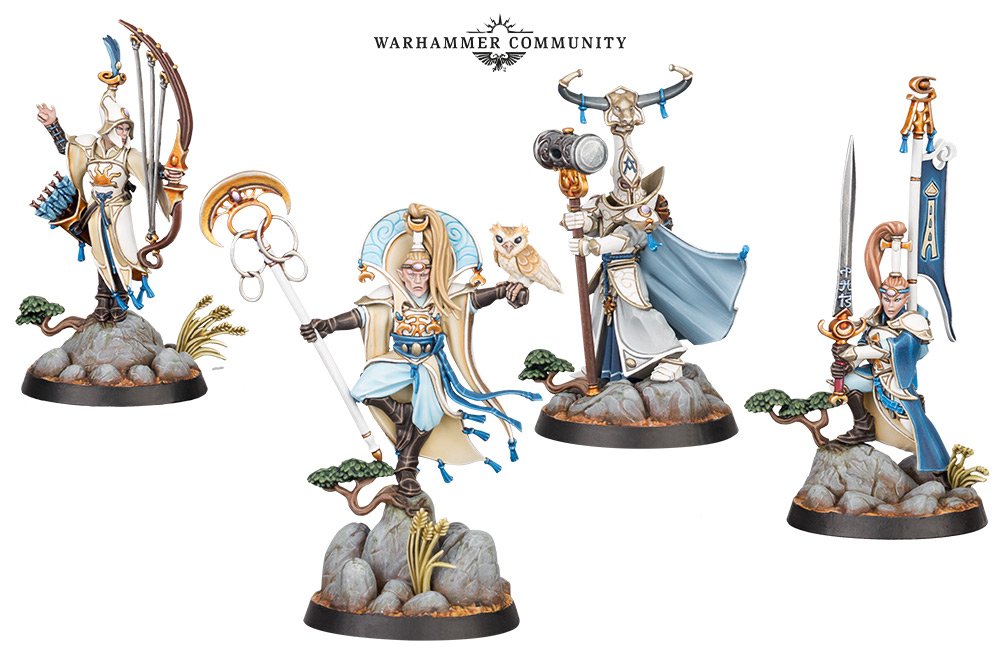
____________________
The Dread Pageant – Deck – My Rating: B
The Dread Pageant (faction review here) are a very cool warband with varying strengths and weaknesses. They have a curious mix of strong and weak fighters for a 4 fighter warband, and some very strong cards to help make up for a very difficult inspire condition.
In Rivals, their objective deck contains 5 surges, a whopping 22 total glory, and zero third end phase cards. A lot of the glory comes from the fairly hard to score without having already won the game 6 glory Beautiful Deaths, but the other 11 cards are much easier to score, and make this objective pretty strong, I think.
Their gambit cards do a good job of supporting the warband, with solid ways to mitigate damage, ping enemy fighters to help inspire, and generally control the board.
The upgrades are probably the weakest part of the set, but still have a decent amount of damage and utility to keep the warband going.
Overall I think the warband plays with a focus on controlling objectives in Rivals, before hopefully inspiring and powering up if possible. As far as fighters go, both Vasillac and Slakeslash are quite good in a fight, and should let this warband hold their own whole Hadzu and Glissete try to hold objectives and not die. I think this is likely a great Rivals deck for both new players and old, as it showcases a lot of cool strategies and mechanics of the game.
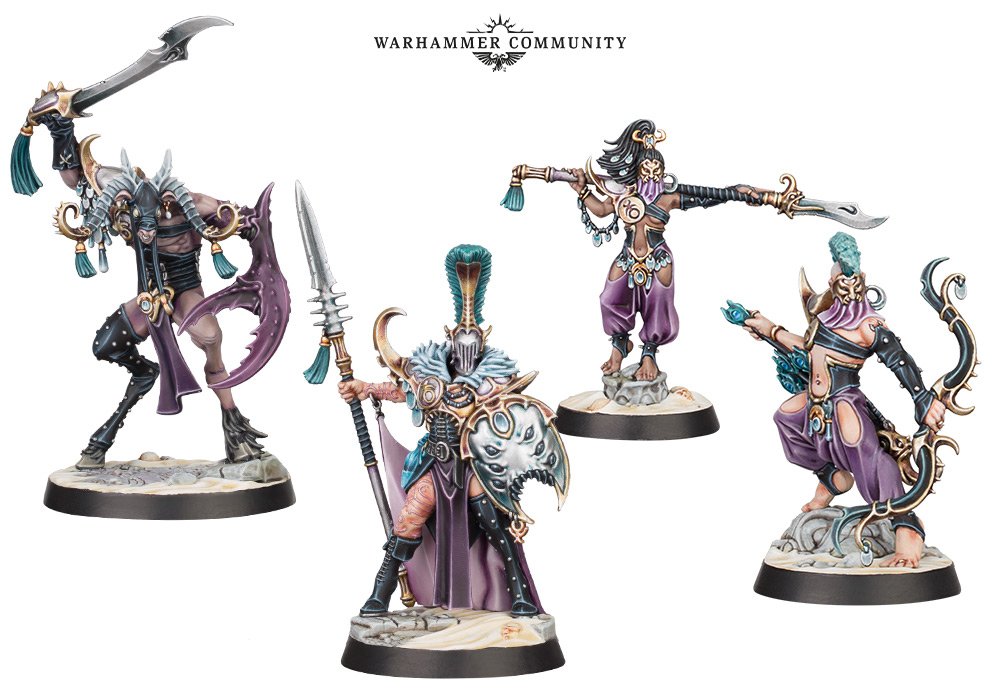
____________________
Khagra’s Ravagers – Deck – My Rating: C
The Ravagers (faction review here) are unfortunately known as the weakest Direchasm warband, with a desecration mechanic that doesn’t really work very well, and a wizard that can be a bit more of a liability than a strength sometimes. While these things are still true when they play their Rivals deck, I actually think things may not be as dire as in Championship, since the card advantage is in some ways minimized, and the raw stats of the 3 non-wizard fighters can shine.
Objective wise, they have 5 surges, 1 third end phase card, and a total of 19 glory. 4 of this glory is tied up in Absolute Desecration, which is very hard to score. The rest of the objectives are mostly scorable if you can lay down some desecration tokens, though the requirements around the desecration mechanic look like they will only be harder in Harrowdeep if the objectives are harder to find (pesky gloom!).
The warband’s gambit cards are actually fairly strong, with good mobility, damage, and accuracy, and 2 cards to help with the desecrating. They do have 2 spells, but they are strong cards if you can keep the wizard alive long enough to cast them.
Similarly, the upgrades are pretty solid as well, with +1 damage, +1 wounds, and permanent guard on different cards, as well as some very neat cards like Hellfire Sword.
I think this warband will play very aggressively in Rivals, but their main weakness is their desecration mechanic, which may result in them being forced at times to ignore their desecration objectives as too difficult, which is a lot of glory to give up. I wouldn’t exactly recommend this warband, but players may be able to find success with them due to their raw stats and power cards combined with the generally low power of the decks they face in Rivals.
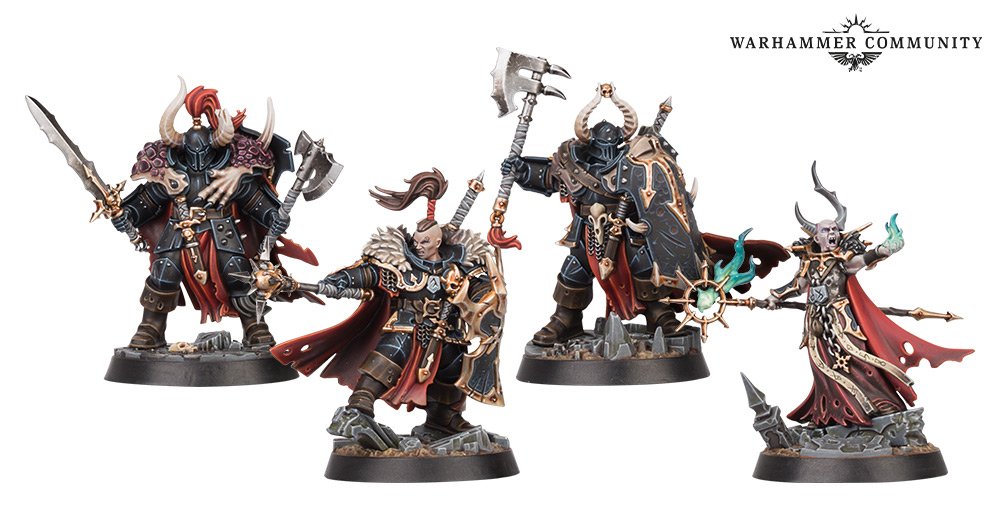
____________________
The Starblood Stalkers – Deck – My Rating: B
The Starblood Stalkers (faction review here) are an aggressive hold objective warband with some great faction cards, which makes them a decent choice to play in the Rivals format.
With 5 surges, 18 glory, and zero 3rd end phase cards, their objective deck looks good, but is actually where the challenge lies. The hardest part of this deck has to do with scoring The Great Plan, which is a great card in Championship, but relies in Rivals on scoring either Children of Ayr or Perfect Warrior plus Seeking the Heart or Balance the Cosmic Equation. This actually strikes me as sort of difficult, and has the potential to lock up quite a bit of glory if the cards come out in a bad order.
The Stalker’s gambit cards really are some of the best in the game, so no problems there. They really do everything that they want, with amazing accuracy, mobility, and disruption to keep in control of objectives across the board.
The upgrades are about average, with some solid durability and accuracy cards, but a higher than would be ideal number of fighter restricted cards with a heavy focus on the leader and skinks.
Overall, I think the Stalkers take quite a hit in Rivals compared to Championship due to the issues with their objective deck, but their great gambits just keep them in the B rating for me, and I still think they are playable enough for this format with an aggressive/hold objective playstyle and strong player focus on making the Great Plan come to fruition.
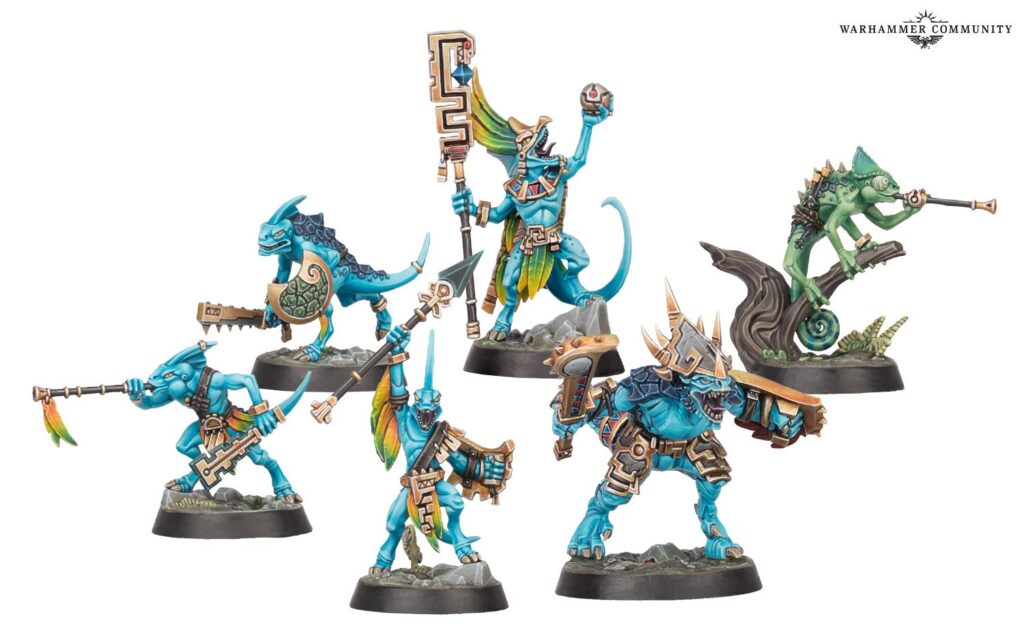
____________________
The Crimson Court – Deck – My Rating: A
Everyone’s favorite vampires, the Crimson Court (faction review here) are a very flexible warband with exclusive access to the Hunger mechanic in the Rivals format (and near exclusive access in Championship).
Their objective deck has 5 surges, 17 total glory, and 1 third end phase card. Interestingly, this deck has very little scoring based on having Hunger counters, and is almost entirely a full aggro deck, with a focus on killing and inspiring fighters. The main exception is Death’s Domain, which may be too hard to do in some games, or possible due to gloom in others. Overall I think this objective deck is very strong for the aggro playstyle.
The gambits and upgrades are generally good, with the worst of them being focused too heavily on the Hunger mechanic, which isn’t really needed for this deck other than to bloodthirst or possibly score Blood Curse. They pretty much have everything they need as far as ways to hit harder and be harder to kill, with some interesting tech cards thrown in.
As stated, the warband style is almost full aggro in Rivals, and should be quite good at it.
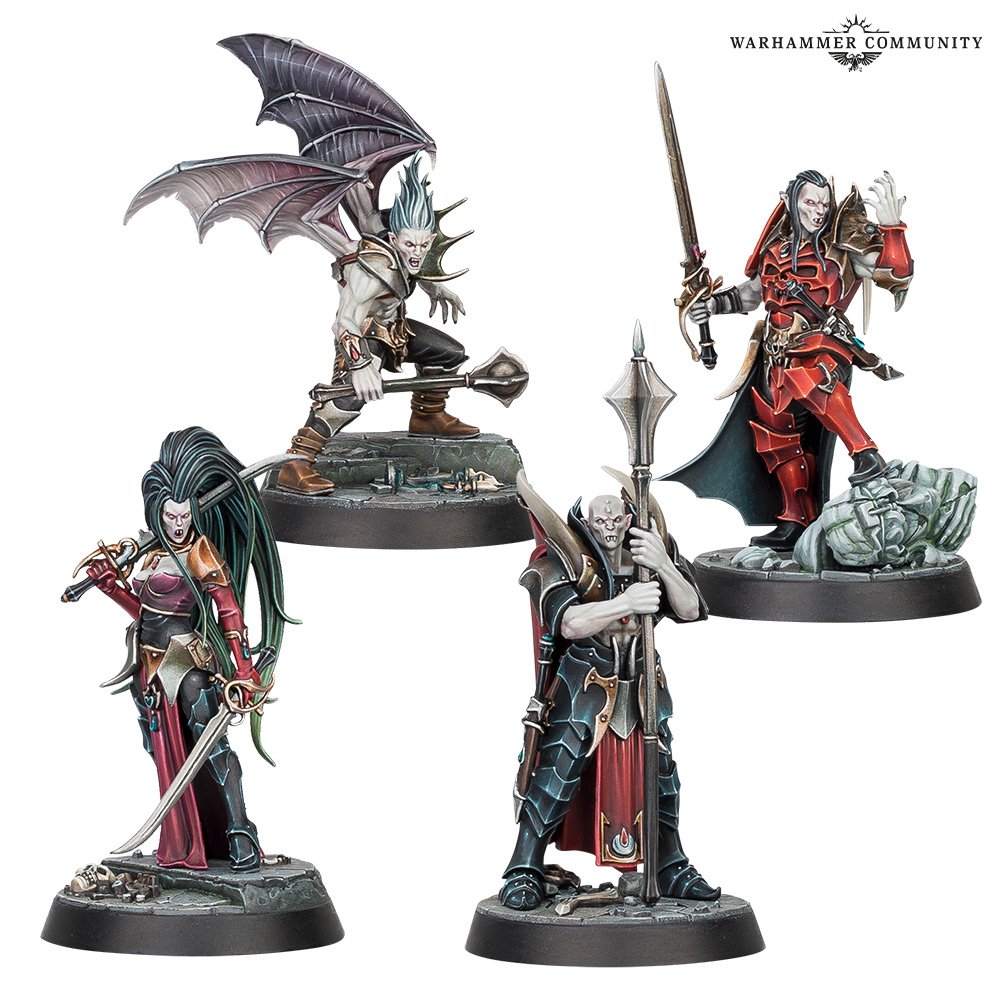
____________________
Hedkrakka’s Madmob – Deck – My Rating: B
The Madmob (faction review here) are an orky aggro warband with exclusive access to the Primacy mechanic in the Rivals format.
Their objective deck is decent, with 5 surges, 1 third end phase card, and a total of 17 glory, and solid scorability on most of the cards, though they do rely somewhat on having Primacy, and cards like Hunt the World Spirit and Weird Omens can be a bit hard to score at the same time as other cards.
The Madmob’s power cards are decent as well, with extra bonuses for having Primacy, and extra ways to gain Primacy. Their upgrades are okay, with tons of accuracy, durability, and a variety of effects having to do with Primacy.
Overall I think this warband performs well in the Rivals format with an aggro playstyle, with their heavy advantages when it comes to gaining and not losing primacy making up for a bit of an average objective deck, and their solid stats keeping them in the fight.
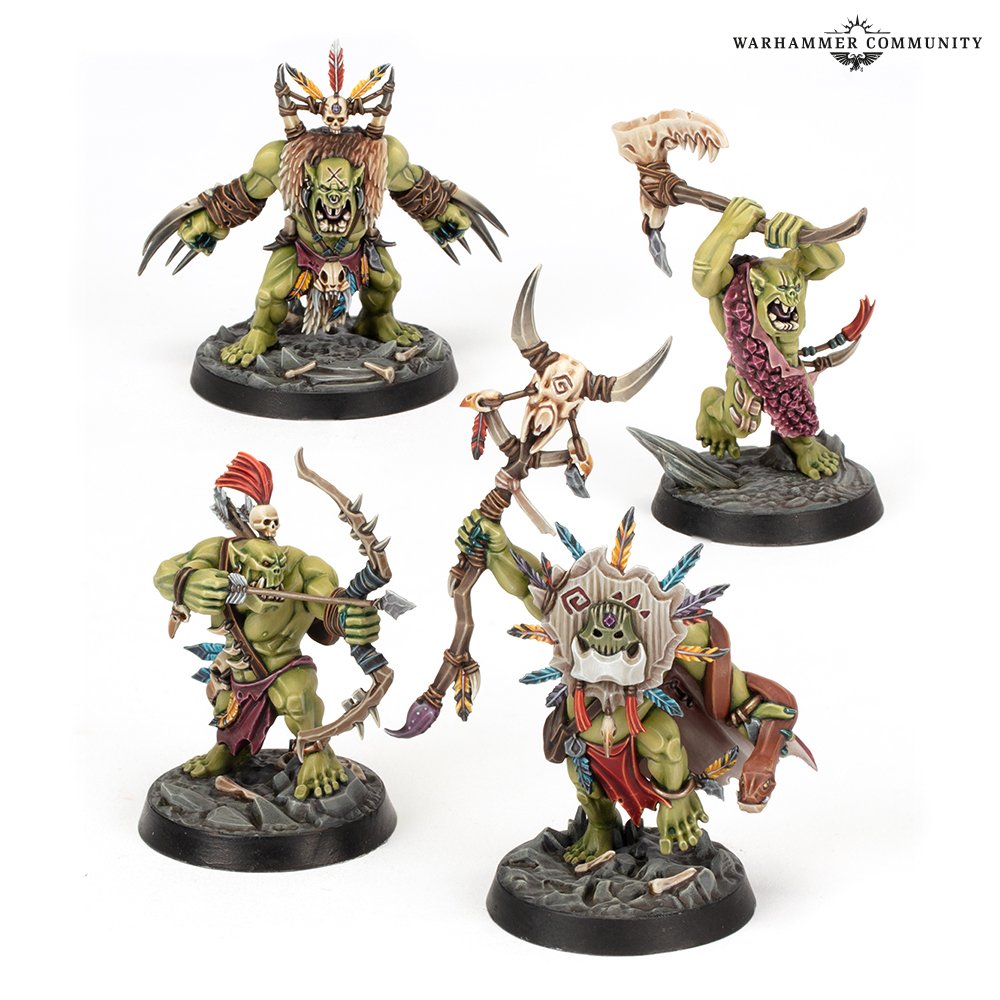
____________________
Kainan’s Reapers – Deck – My Rating: B
The bonereapers (faction review here) are very unique warband, with one of the biggest fighters in the game alongside some of the smallest, and an inspire condition that requires kills or choices from the opponent. In Rivals format they are very aggressive, though they can be quite flexible in Championship.
Their objective deck is pretty good, with 5 surges, 1 third end phase card, and 17 total glory. I am not a big fan of the third end phase card, Peerless Conquerors, since it requires you to hold on to your Tithe counters, but it is scorable, and something you should probably work towards in this deck. Otherwise, most of the cards are quite scorable, with a heavy aggro focus.
The gambits and upgrades are pretty good as well, with a heavy focus on the Morteks.
Overall, I think this deck functions, but it has a heavier aggro focus than I would normally want to play in championship, and it requires the morteks to play aggressively, making the deck have a little less flexibility that I am used to with this warband. However, the leader is so powerful and hard to deal with that I still expect this warband to do quite well in Rivals.
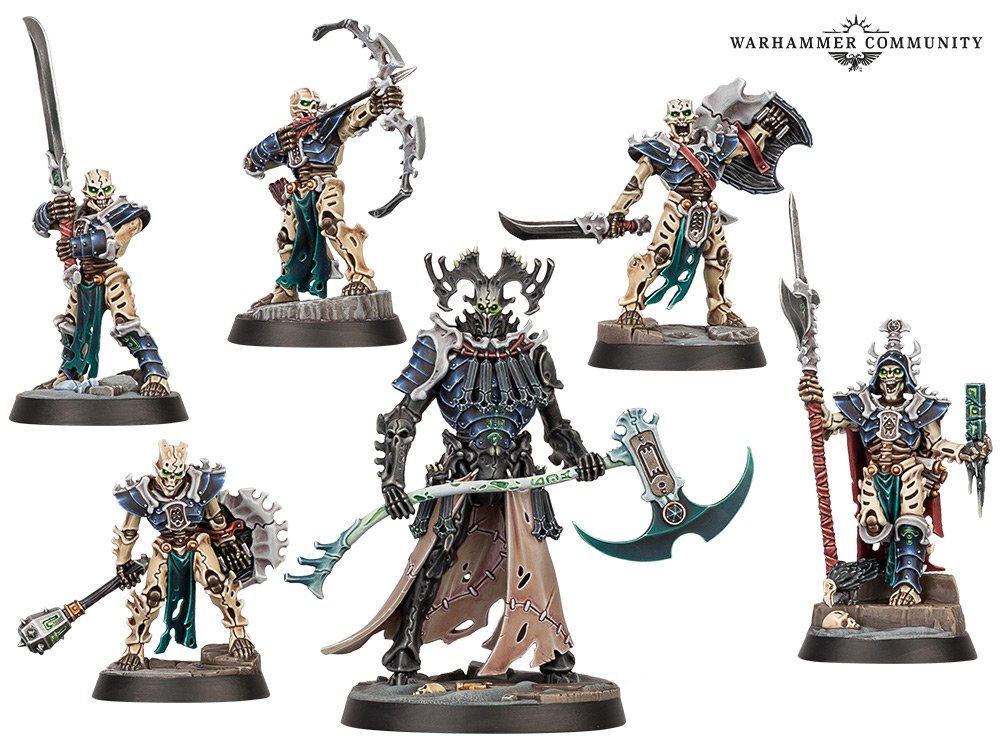
____________________
Elathain’s Soulraid – Deck – My Rating: B
The fish, elf, and crab warband (faction review here)! The Soulraid are a very interesting warband with high mobility, amazing round 2 aggro power, and a very annoying fish.
In Rivals, their faction objective deck has 5 surges, 16 total glory, and 1 third end phase card. Dead or Doomed is fairly difficult as far as third end phase cards go, but the fish does help with the adjacency option, so keep that in mind. Otherwise, their objectives are all mostly scorable with an aggro focus.
Their gambits are a very curious collection of control type card cards that can mess up an opponent’s plan, but are generally low power with a few exceptions like Spinefin Toxin.
Upgrade wise, they have a decent selection, with ways to get more accurate, harder to kill, and various tech cards, though there are a lot of fighter restrictions.
Overall I think the Soulraid have a very fun Rivals deck with an aggro focus, and lots of ways to mess up the enemy.
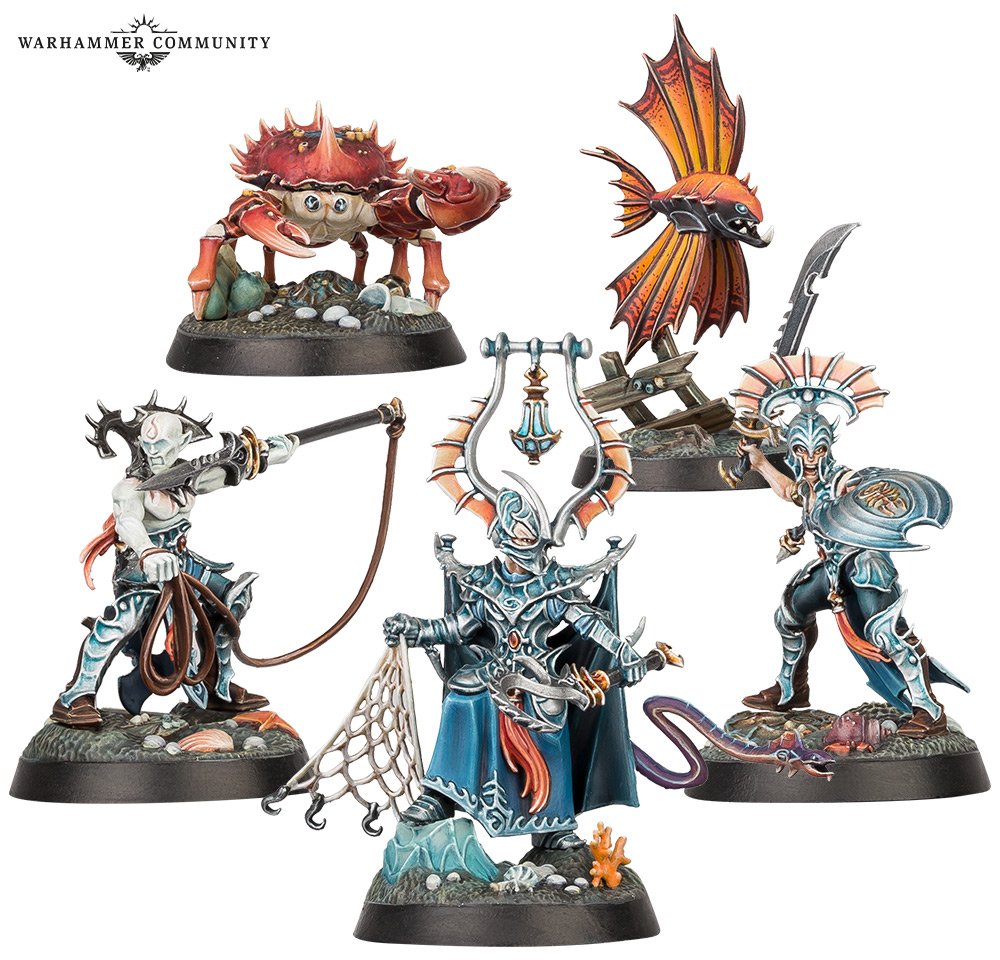
____________________
Drepur’s Wraithcreepers – Deck – My Rating: A
The creepers (faction review here) are a very strong warband with a focus on aggro and holding objectives, and a particular focus on the leader murdering everything in both Rivals and Championship.
The wraithcreepers have a very solid objective deck with 5 surges, 16 total glory, and zero third end phase cards. The power of the deck comes from the high scorability of the cards, with most being very playable, though they do have more of a focus on using all of their fighters in Rivals than in Championship due their need to have hold objectives and have fighters in enemy territory. They also need to kill quite a few enemy fighters in order to score through their deck, with rewards for 2, 3, and 4 fighter kills, so may have some trouble vs smaller warbands. Piercing Blow is probably the worst card in general, as you have to rely on Heart-piercer to gain cleave, or keep Haqfel around long enough to score it.
Their gambits are also very strong, with pushes, extra attacks, and drum beat cards to mess up the opponent. There really isn’t anything too fancy here, but they almost all have pretty solid effects.
The upgrades are slightly worse, with a number of strong but basic cards like +1 Wound and +1 Damage, a few useful accuracy cards, some very situational fighter restricted cards, and the amazing defensive card Pall of Fear.
Overall I think this is a very strong deck with an aggressive hold objective style that needs to move into enemy territory as quickly as possible. It is nowhere near as powerful compared to other warband decks as they were in Championship, since it is much harder to make Drepur an unkillable whirlwind of death due to fewer +1 damage cards, and fewer durability cards.
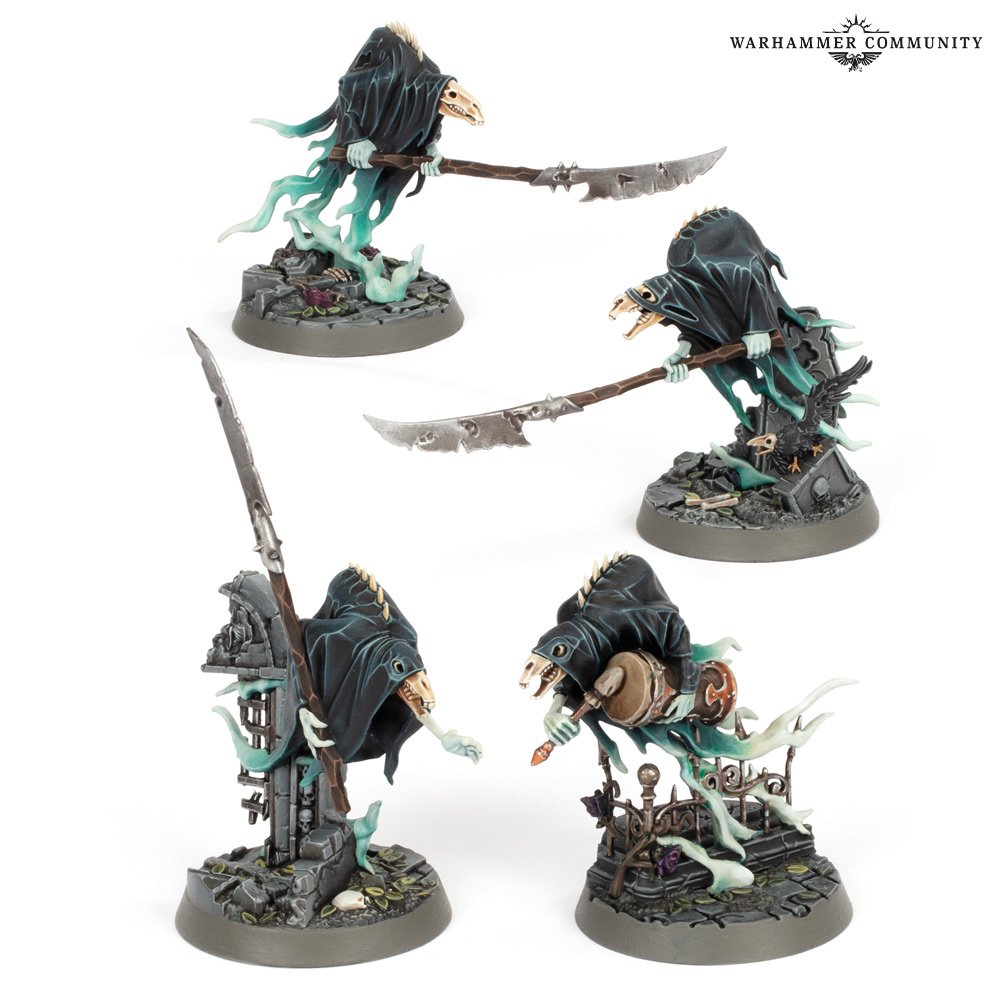
____________________
Storm of Celestus – Deck – My Rating: C
The Stormies (faction review here) are one of my favorite warbands to release in season 4, and the other half of the starter set along with the Wraithcreepers. Their playstyle is an interesting mix of aggro and hold objective, and they have the only pet that can hold objectives (Riptooth is no pet!). They are not the easiest warband to play in any format, but I think they are fun to try and figure out in Championship despite their low rating here.
The Rivals objective deck for the Stormies contains 5 surges, zero 3rd end phase cards, and has a total of 17 glory. Their surges are sort of strange, either requiring them to hold specific objectives after an opponent’s activation, or to make attacks and kills at range 1. This is doable, but is made harder in Harrowdeep when you don’t know where all of the objectives are due to gloom, and sometimes goes against what you want to do with them (shoot one thing, then charge another with range 1). Their end phase objectives are generally scorable, but seem to be slightly more difficult than the amount of glory they are worth, and hard to score all at once, which makes this deck difficult to get through sometimes.
Their gambit cards are pretty solid, with a number of pushes, some good defensive cards, and only one real dud (Lightning Flare).
The upgrades are a bit below average, with their best cards being fighter restricted, and their only damage upgrade only working on range 1.
Overall I think this warband’s Rivals deck is playable in an aggro/hold objective style, and the main strength of the warband is great ranged attacks and the ability to shoot one target and then charge another with one fighter (getting multiple activations per fighter is a big deal for smaller warbands as they lose fighters) but it is relatively low power, and sort of lacking the tools needed to make up for some of their weaknesses (low damage), while asking too much of 4 fighters (holding all of those objectives).

____________________

Beastgrave Warbands:
With the start of season 5, these warbands are likely to start being harder to find in stores, and the universal cards are no longer used in Championship, so new players may not be as interested in or able to play these, but they may still see them across the table, or be enchanted by their miniatures or mechanics enough to track them down, so I think it’s worth going over them as well.
____________________
Lady Harrow’s Mournflight – Deck – My Rating: A
Starting off strong, Lady Harrow’s Mournflight has been a powerful Warband since it’s release, the main reason being the large number of very powerful faction cards in addition to solid fighter stats and mechanics. Check out Aman’s initial Dreadfane review with all of their card’s here.
With a combined 18 glory, their objective deck contains 5 surges (2 of which are currently restricted in championship!), and 1 third end phase card. The general quality of this objective deck is quite high. Cards like Fleeting Memories, One Will, Inescapable Hunger, Nexus of Terror, Ghostly Torment, and Dominion of Death show up frequently in Championship decks. There are definitely some weaker cards in there as well, but I think the average power is still quite high.
The power deck is also quite solid, with lots of enemy pushes, solid defensive, accuracy, and utility cards that can do well in a variety of situations. They do lack a bit in the damage department, but I think that is fairly average for faction decks.
In general, Lady Harrow’s players are likely to have a number of strong cards in their hand at any given time, and if they don’t, they can probably just mulligan to get some.
The deck and warband abilities definitely lends itself to a hold objective/aggro style that wants to be close to the enemy (moving through fighters to inspire and gain some pretty scary stats), which probably isn’t quite as strong as some of the more defensive championship builds, but should give most other Rivals decks a run for their money.

____________________
Ironsoul’s Condemners – Deck – My Rating: D
Universally mourned as one of the weaker warbands in the game, Ironsoul’s Condemners might actually get a bit of a buff in Rivals, due to solid offensive fighter stats and the net loss of power the other warbands experience, but probably not enough to make them very interesting. Once again, Aman’s review here.
Their Objective deck has 4 surges, 15 glory, and 0 third end phase cards. This seems a little weak on its face, and in general the cards don’t really impress with their scorability.
Their power deck is better, in that it does contain a number of very strong upgrades and gambits, and most will be found useful in most games.
Their deck pretty much forces them to play a slow, hard hitting aggro style, which is probably what they wanted to do anyway. In general I don’t think this warband+faction deck really stands out to me much, but it might be a good one to play vs new players, since doing well with it is probably a challenge even for veteran players.

____________________
Skeath’s Wild Hunt – Deck – My Rating: B
A favorite warband of the Path to Glory team, I think the Wild Hunt (faction review here) have a pretty solid faction deck.
Their objectives include 15 glory, 4 surges, and no third end phase cards, but a large number of their cards are actually scorable.
Their gambits are fairly strong, though a bit heavy in spell department, which just means you may need to be extra aware of keeping Karthean safe. The upgrades are very solid as well, with solid options for durability and accuracy, though lacking a bit when it comes to damage.
In general I think the Wild Hunt will focus on an aggro style in Rivals, with a little focus on objectives with Purifying Rites (which may be a lot easier with Harrowdeep’s Gloom mechanic), and probably be reasonably fun to play for new and old players alike.
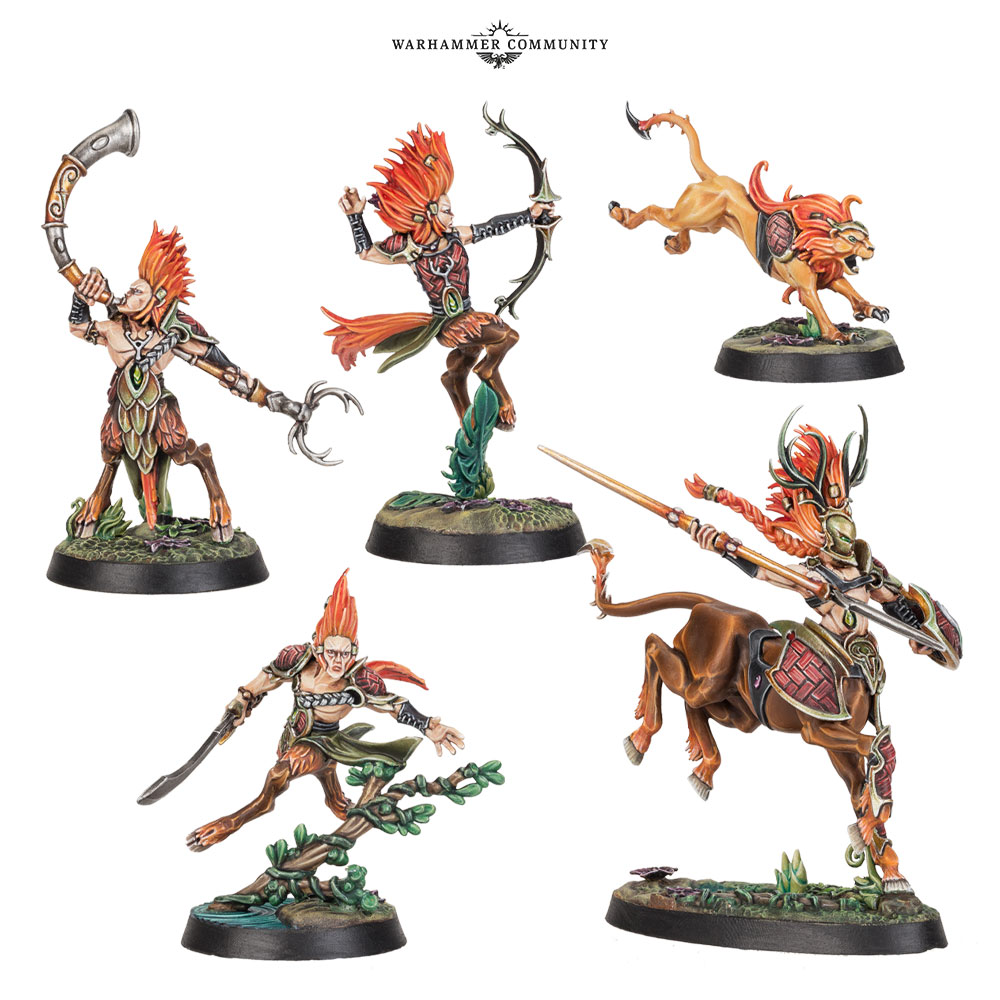
____________________
Grashrak’s Despoilers – Deck – My Rating: C
Despoilers (faction review here) are typically viewed as the weaker pair from the Beastgrave starter box, and a lot of that has to do with their faction cards (as well as their difficult inspire condition, and lack of meaningful gains in inspired stats).
Their objective deck is actually half decent with 5 surges, 16 glory, zero third end phase cards, and a number of very scorable cards.
The real weakness for the Despoilers is their power deck, which contains some of the most situational cards in the game, with a whopping 9/10 upgrades having fighter restrictions of some kind.
I think the Despoilers are reasonably playable due to their decent objective deck, but perhaps not the most fun to play in Rivals due to the lackluster nature of their power deck. I could see pulling them out to play vs new players, but are not something I would recommend a new player track down to play.
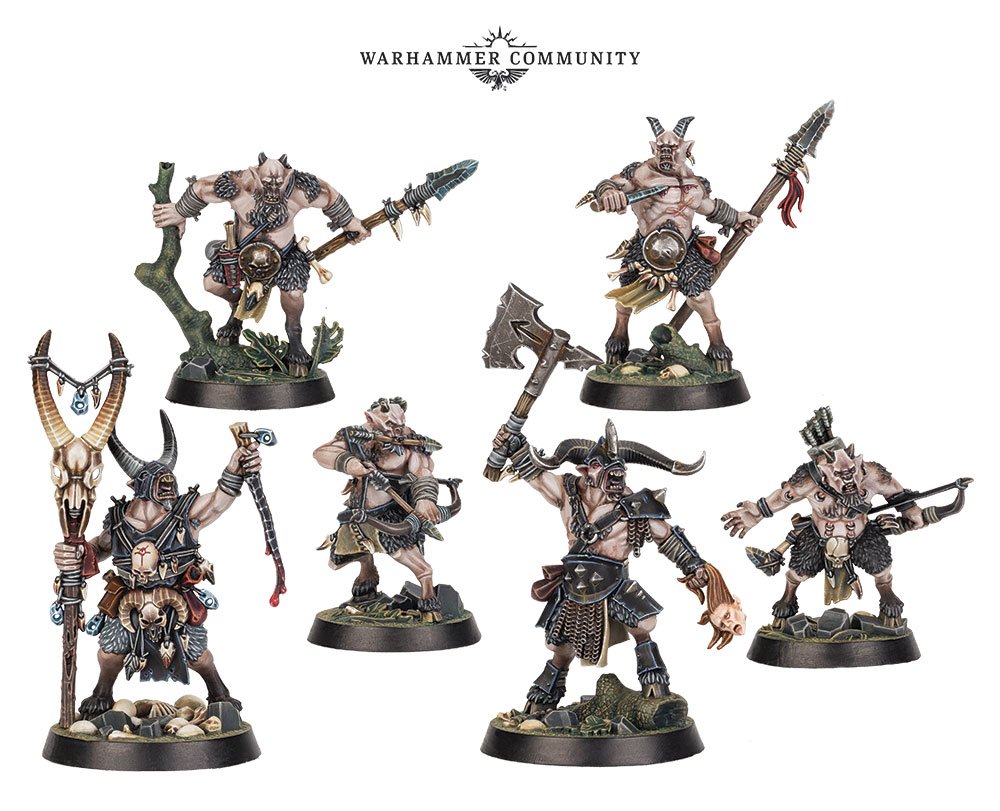
____________________
The Grymwatch – Deck – My Rating: A
The Grymwatch (faction review here) are another powerful warband with some really great faction cards. With 16 total glory, 6 surges (2 of which are restricted in championship), and 1 third end phase card, their objective deck is very strong, with lots of glory for holding objectives and killing enemy fighters.
Their power deck is also quite strong, with lots of pushes, a rez card, solid damage and accuracy cards, and even a few ways to remove enemy upgrades.
Their main weakness is losing too many fighters over the course of the game and triggering other warband’s high glory cards for killing fighters, and I do think they are a bit weaker in Rivals compared to their heyday in championship, but are still likely to be one of the tougher warbands out there based on the strength of their cards and inspired stats.
The deck should play in an aggro/hold objective style, focusing on scoring glory and keeping the enemy fighters out of your territory in the first round in order to power up via the inspire, and then focusing on outnumbering and taking the enemy fighters down.

____________________
Rippa’s Snarlfangs – Deck – My Rating: B
Rippa’s Snarlfangs (faction review here) are a very cool warband with what looks like a solid Rivals deck to me.
Their objective deck is mostly aggro focused, with 5 surges, a whopping 19 glory, and no third end phase cards. The glory total is a bit skewed by Lay Waste, which is 5 glory and not very scorable, but the rest of the cards are generally pretty good, with an aggro focus.
Rippa’s gambits are particularly strong, with most of them showing up at some time or another in different Championship decks, and they have some very strong upgrades as well.
With only a few real duds card wise and powerful fighter stats, I think the Snarlfangs are a solid aggro Rivals warband, if perhaps a bit reliant on the dice of their wolf attacks, and somewhat less able to hold back and strike at the perfect time compared to Championship.
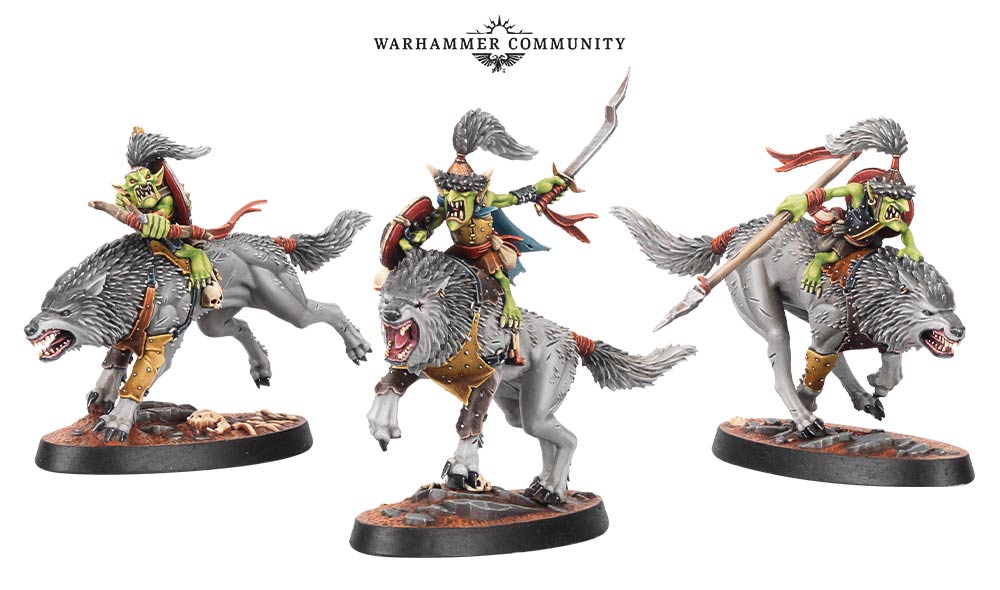
____________________
The Wurmspat – Deck – My Rating: D
Despite being a warband with a few Grand Clash style event wins under their belt, the Wurmspat (faction review here) are also unfortunately a Warband known for their remarkably bad faction objectives.
They have only 3 surges, have 2 third end phase cards, and a total of 18 glory. Sadly this does not make for a very functional objective deck, and many of the cards are difficult to score, which makes Rivals tough for them.
Their gambits and upgrades are okay, and but the Cycle mechanic is actually sort of a nerf to those cards, they have 3 spells, and a large number of cards restricted to different fighters. This makes it hard for them to make up for their built in fighter stat weakness (speed, inspire) or lean into their strengths (durability, hard hitting).
Overall I think this Rivals deck is very hard to do well with, and unless you are a veteran looking for a challenge vs new players, I probably wouldn’t recommend it.

____________________
Hrothgorn’s Mantrappers – Deck – My Rating: B
Hrothgorn (warband review here) has a very strange faction only deck due to the number of surges he has.
With 8 surges, zero third end phase cards, and 20 total glory, Hrothgorn objective looks at face value to be one of the best we’ve seen yet. That said, the scorability of many of the surges is fairly low, with Boxed In, Surprising Competence, and Dinner Time being extremely hard to score. Overall I think this puts the objective deck somewhere in the middle card wise, with some dead cards and some very strong ones. Hrothgorn can probably afford to use activations early game to cycle out objectives, but drawing into duds may be a real issue.
The power cards are generally good, with a few duds, but the primary strength of the Warband is found in Hrothgorn himself, and how difficult a fighter like him is to deal with in the Rivals format.
The deck generally forces Hrothgorn to play aggressively and get kills while the smaller fighters try not to die. I think this warband is probably fun enough to play, but not as consistent as some of the others.
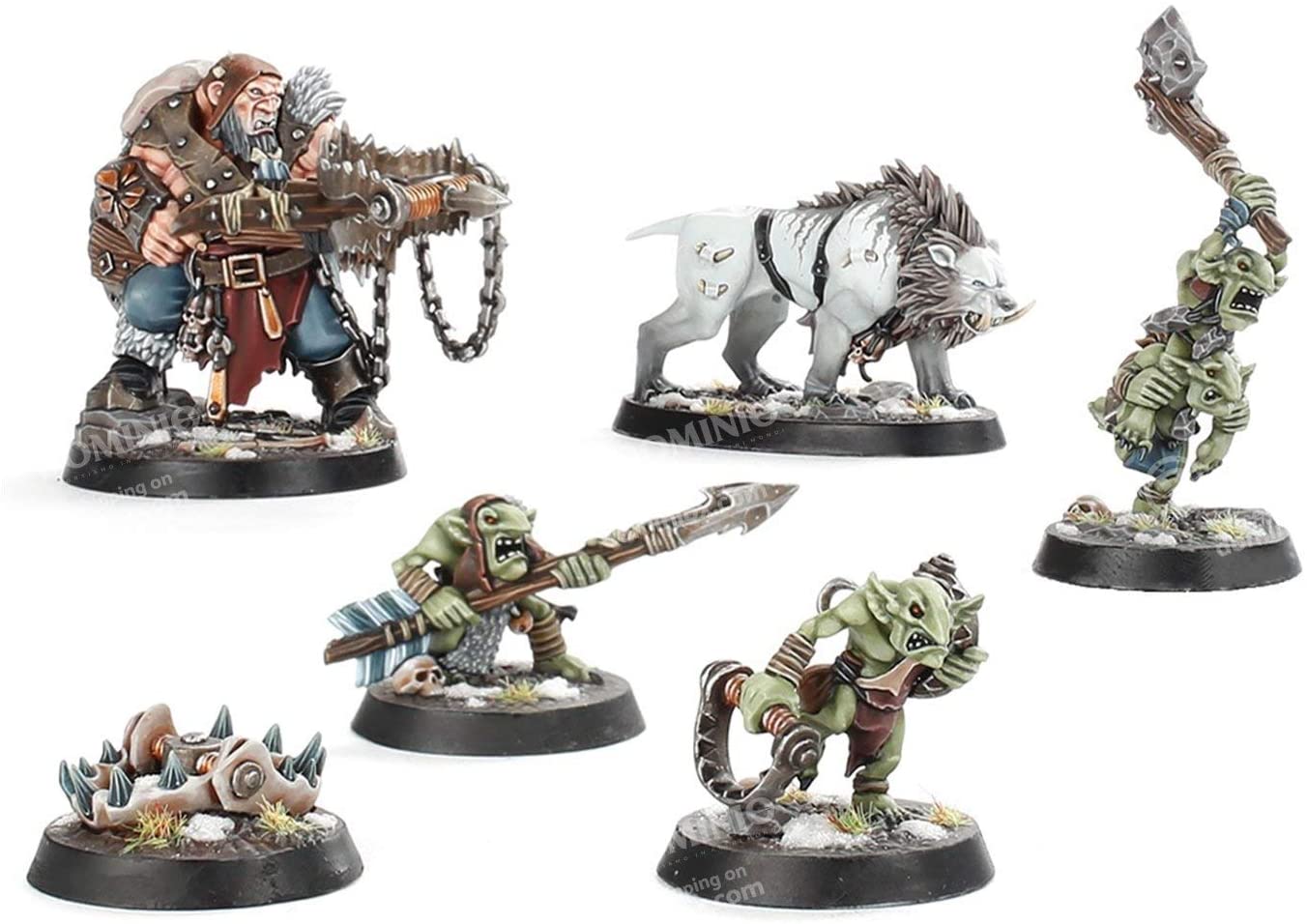
____________________
Morgwaeth’s Blade-Coven – Deck – My Rating: C
The Blade-coven (faction review here) are another warband known for their low power, mostly due to their lack of durability, and I think this holds true in Rivals format as well, but perhaps not as much as in Championship.
Their objective deck has 5 surges, 17 glory, and one third end phase card. Overall I think this is decent. The surges are mostly centered around killing, but are all reasonably scorable and stackable, if a little dependent on the positioning of objectives (which actually could be an issue in Gloomy Harrowdeep). Proof of Devotion and Ritualized Formation are probably not going to be scored very often, but the rest of the deck seems okay compared to most.
Their gambit cards are actually quite good, with some cool power plays like Headlong Fury, Zealot’s Rage, and Catechism of Murder, and the rest playable enough. Their upgrades are more of a mixed bag with a lot of fighter restrictions, but they do have a decent mix of accuracy and damage in there.
Overall this warband might find more success in Rivals than in Championship, but I think their low durability and difficult inspire condition leave them wanting more in either format. Probably fun enough for veterans to pull out and play vs new players, though.
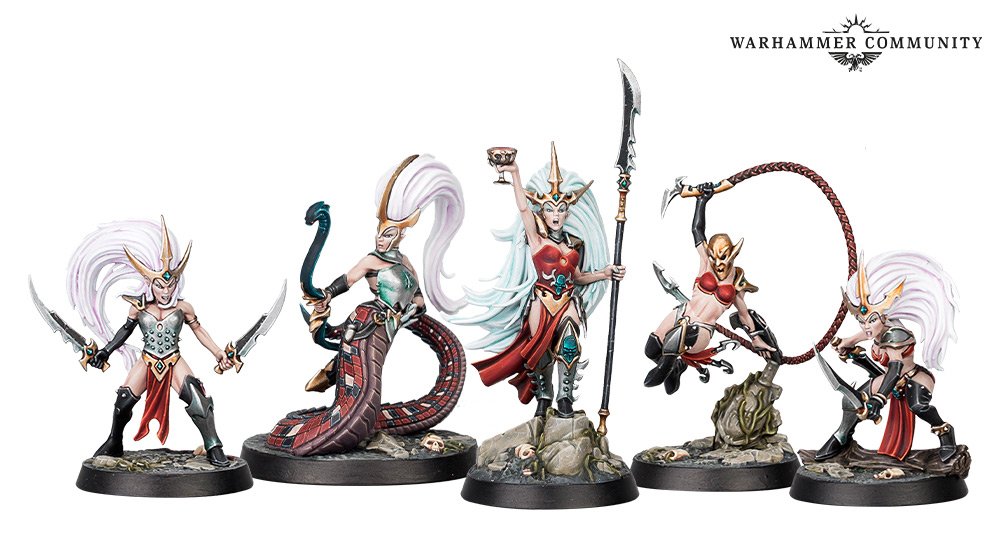
____________________
Morgok’s Krushas – Deck – My Rating: B
The Krusha’s (faction review here) are some of the toughest fighters around, and I think that will stay the case in Rivals.
Their objective deck has 5 surges, 17 glory, and 0 third end phase cards. This is solid on it’s own, and the card quality is fairly high here as well, with at least 3 easy surges (Got It, Boss – Now Wot? – Orruk Kunnin) and everything else other than Brute Triumph being mostly reliably.
Then they have a great selection of power cards spread across both power and upgrade cards, with lots of damage reduction and aggro power.
This warband will play very aggro in Rivals, with some focus on objectives to score their surges, and be incredibly hard to kill. In general I think their main weaknesses are their slower speed, but once they close the distance and start hitting things, they should do quite well.
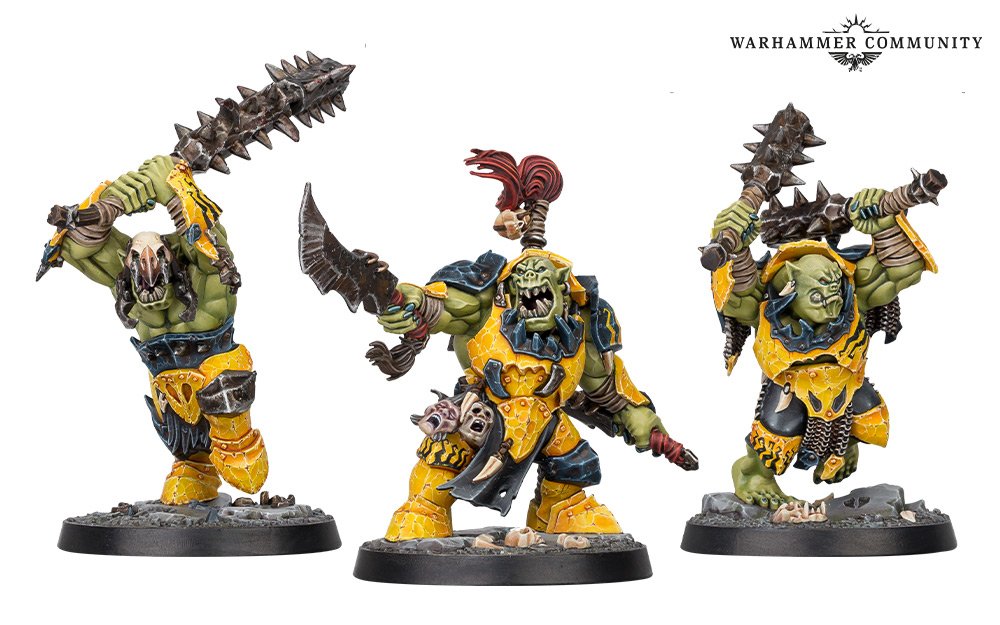
____________________
Summary:
- A – Very Playable – Grymwatch, Crimson Court, Wraithcreepers, Lady Harrows (ALL of the Death warbands!).
- B – Solid Choice – Purifiers, Dread Pageant, Starblood, Madmob, Kainan’s, Soulraid, Wild Hunt, Rippas, Hrothgorn, Krushas.
- C – Challenging – Ravagers, Despoilers, Stormies, Blade-coven.
- D – Hard Mode – Silent Menace, Condemners, Nurgle.
My rating is pretty B heavy, but I think I stand by the ratings (though I think you could argue for Krushas, Kainan’s, and Hroth to be a bit higher) for the reasons given, and honestly think you can win 50% or so of your games with and against most of the B tier warbands. Above and below that, I think the reliability of win rates starts going up or down.
____________________
Final Thoughts:
Phew, that is a lot of warbands! All in all, I think this is a reasonable selection of options for players to choose from in the existing warband selection. Although there are a few duds there, and Rivals if not as deep a game format as the deck building ones, I do think it seems fun enough to play with new players, and is an objectively easier way to learn the game for new players.
And, despite a definite shallowness to it, I think there would still be an interesting enough meta with so many warbands to choose from and their strengths and weaknesses vs each other. Also as more decks are released, if they are actually worth playing instead of a warband’s faction cards, this may actually give the warbands a very different feel than we are used to in Championship now, where every deck for a specific faction actually tends to have a lot of the same cards in a given meta, vs a Rivals meta where they might use 2 or even 3 viable ways to play in this format with completely different sets of cards.
I know that I am personally planning on bringing 2-3 Rivals decks with me on game nights to play vs new players, and to use in intro games with prospective players in the hopes of growing the local community.
Thanks for reading. If you liked this article, great! If you think I missed anything, or could do something better the next time, let me know in the comments.
As always, best of luck on your Path to Glory.
Jonathan
